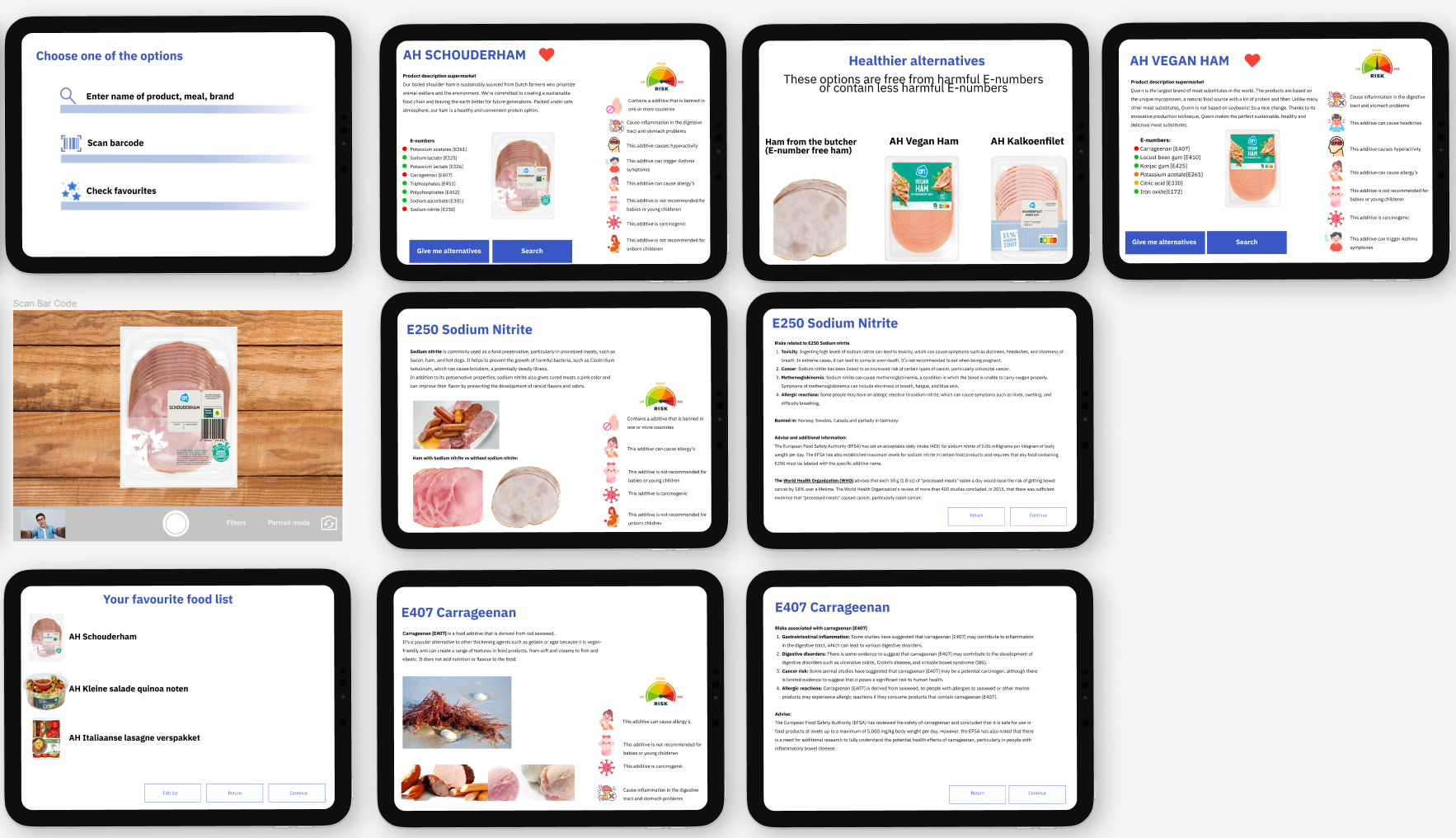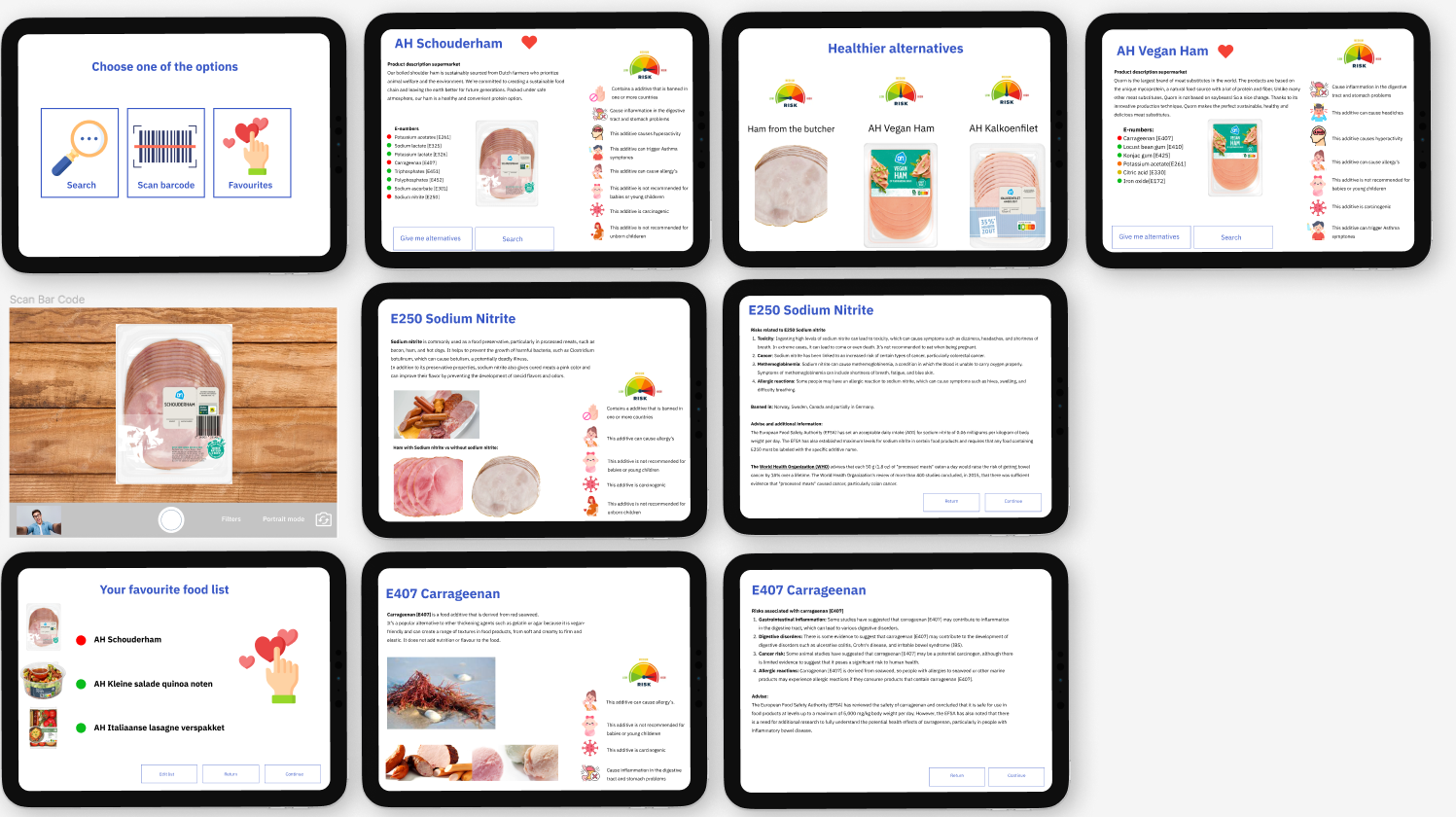Premise
Using a recommender system to help parents with young children make informed decision about their processed food consumption, by providing personalized recommendations based on their dietary preferences and allergies.
Synopsis
The use of E-numbers in the food industry has been associated with potential health risks, as various studies have demonstrated that not all E-numbers are safe for consumption, especially for children. Despite this, some adults remain unaware of the presence of hazardous E-numbers in the foods they and their children consume. To address this issue, a prototype of a recommender system has been developed to assist people in making more informed choices about their food. The recommender system takes into account the dietary preferences, allergies and provides healthier recommendations. Through tracking their progress, viewing recommendations, and providing feedback, users can refine their preferences. Ultimately, the aim of this recommendation system is to enable individuals to make better-informed decisions about their food intake, which may lead to a healthier lifestyle.
Substantiation
Unhealthy processed foods has been identified by the World Health Organization (WHO) as the leading risk factor for global deaths, resulting in approximately 11 million fatalities annually (WHO, 2020). Unfortunately, processed foods have become increasingly available and consumed worldwide, despite their potential negative health impacts. These foods often contain additives, including E-numbers, which are used to enhance flavour, texture, appearance, and shelf life. However, some E-numbers have been associated with health concerns, such as allergies, hyperactivity, and cancer. Unfortunately, many consumers lack awareness of E-numbers and their potential negative effects due to complex naming, unclear labelling, and unreliable information (Szűcs, V., 2016; Van Gunst & Roodenburg, 2019; Avram et al., 2021).
Unfortunately, the lack of awareness among consumers regarding E-numbers and their potential negative effects is a major concern. Studies have found that a small percentage of consumers understand the purpose of E-numbers or consider them to be safe for consumption (Szűcs, V., 2016; Van Gunst & Roodenburg, 2019). Additionally, the complexity of E-number names, unclear labelling, and unreliable information make it challenging for consumers to identify the potential health risk associated with the E-numbers (Avram et al., 2021).
To address these challenges, a multifaceted approach is necessary that includes educational programs, increased labelling requirements, and consumer engagement strategies. Additionally, recommendation systems can serve as a useful tool in promoting informed decision-making, particularly regarding hazardous E-numbers (Vasiljevic, Pechey, & Marteau, 2015). By providing personalized suggestions based on individual preferences and dietary needs, these systems can empower consumers to make healthier and safer food choices (Wang et al., 2021). As such, the integration of informative and technological solutions can effectively improve consumer awareness and facilitate informed decision-making when it comes to E-numbers (Valentine et al., 2022; Van Gunst & Roodenburg, 2019).
Recommender systems
Recommender systems are computer programs that use algorithms to make personalized recommendations to users based on their preferences, behaviour, and other data (Vasiljevic, Pechey, & Marteau, 2015; Jannach et al., 2019). In the context of food and nutrition, recommender systems are used to provide personalized recommendations on what to eat based on a user’s dietary preferences, sensitivities to E-numbers, and other factors and influence their decision making (Wang et al., 2021).
To measure the effectiveness of such systems, it is important to consider a variety of indicators and variables. Changes in user behaviour, such as the adoption of healthier eating habits or a reduction in processed food consumption, can be used as indicators of success data (Vasiljevic, Pechey, & Marteau, 2015; Jew et al., 2009). User engagement with the system, measured by the number of recommendations viewed or followed, is also an important metric (Adomavicius, G., Tuzhilin, A., 2005). The impact of using the system over the long term on health outcomes, such as changes in body weight or reductions in the risk of chronic diseases or sensitivity to allergic reactions, can provide insight into the system’s effectiveness (Schroeder et al., 2017).
The focus of this project lies in developing and evaluating a recommender system and health app that assists parents in making knowledgeable choices about processed foods for themselves and their children. This study focusses on the impact of an recommender system and Health app on the parents awareness and decision-making concerning hazardous E-numbers.
Prototypes
The recommender system prototype is developed using Python and conceptual app visualization was created in Figma. Additionally, an Excel database containing all E-numbers used in food has been assembled. The list of E-numbers is sourced from government websites, which detail both approved and banned E-numbers. To enhance this data, a literature review was conducted to gather information on potentially hazardous E-numbers that, despite being approved, may still pose risks to health. Additionally, a literature review on content-based recommender systems was carried out to increase understanding for the system’s development. The prototype will undergo three iterations for improvement.
Iteration 1
A usability test was taken by six parents who possess a technical background, in order to evaluate the functional recommender system and the visual concept of the prospective app. Participants were provided with a document outlining the user test, detailing the steps they needed to follow and the questions they were required to answer. This process offered valuable insights into how users would interact with the system and helped evaluate the effectiveness and usefulness of the information and recommendation system.
Recommender system:

Figma app:

Insights
Recommender system
- Offer information on recommended products by including ingredients;
• Provide the product ingredients to verify if a product is vegan;
• Remove products lacking E-numbers, ingredients, or vegan status;
• Include Nutri-Score in output, add allergy filter and enhance data filters for more reliable and personalized recommendations.
Health app
- Enhance the design and layout for user-friendliness;
- Implement onboarding to clarify app purpose and functionality;
- Offer details on E-number restrictions and risk definition;
- Streamline design and layout, adjusting text colours and objects;
- Improve the E-numbers information layout.
Iteration 2
After critically evaluating the insights from the first usability test. There is agreed upon that the recommender system needed better filtering options, more in depth information, and implement a Nutri-Score filter. The health app required adjustments to the design, layout, text, and explanation of certain elements to enhance user experience. The revised recommender system offered better filtering, more detailed information, and a favourites list function. The updated health app featured improved design, layout, text, and clearer explanations of various elements. Users tested the updated prototype to assess its effectiveness and offer feedback for further refinement.
Updated recommender system:

Updated app:


Insights
Recommender system
- Improve the Nutri-score search, to include equal Nutri-score or healthier search;
- Improve some print statements.
Health App
- Change “hazardous E-numbers” to “E-numbers” on slide 2;
- Revise “considered decision” to “informed decision” on slide 1;
- Replace “ingredients” with “E-numbers” on slide 3;
- Include information about dietary preferences on slide 6;
- Explain the terms located at “select your dietary”;
- Enhance the “favourite food” list with a more visually appealing design and add a risk circle indicator;
- Display risk indicators for the food recommendations.
Iteration 3
Following the second round of user feedback, enhancements were made to the app, including layout adjustments, object relocation, and textual improvements. Similarly, the recommender system’s print statements and Nutri-Score filter were improved. During the critical review there is agreed upon on the need for further optimization of the recommender system and additional improvements to the app’s layout. These insights led to a more effective and user-friendly final concept.
Recommender system:

Health app:


Insights
Recommender system
- The system needs improvement to reduce duplication and false positives that comes from the API provider;
- Users found the application to be accurate and useful;
Health app
- Participants find the app valuable and desire a complete, fully functional version;
- The app influenced users behaviour, leading them to avoid more hazardous E-numbers;
- Some screens needs improvement to align with a modern and simple layout, such as the screens dietary and allergy preferences.
Conclusion
The development and evaluation of a recommender system and accompanying health app to assist parents in making informed decisions about processed food consumption for themselves and their children have proven to be valuable and insightful. By harnessing technology and providing tailored, reliable information, this project has demonstrated the potential for recommender systems to impact consumer decision making, supporting healthier lifestyles and mitigating the risks associated with hazardous E-numbers in processed foods.
Nevertheless, the OpenFoodFacts API has limitations regarding the availability of essential information for most products. This flaw poses a challenge in providing fully accurate recommendations, as crucial data is missing from the product entries. This issue must be addressed in the future.
For future research, it would be beneficial to explore the impact of the recommender system and health app on a broader range of age groups. While the app can be utilized by various user demographics, it is essential to investigate the effects of such systems on children and the elderly to better understand their potential benefits and limitations.
References
Avram et al. (2021). Knowledge about food additives among adults – pilot study. https://mattioli1885journals.com/index.php/progressinnutrition/article/download/1063 1/9434/64970
Adomavicius, G., & Tuzhilin, A. (2005). Toward the next generation of recommender systems: A survey of the state-of-the-art and possible extensions. IEEE transactions on knowledge and data engineering, 17(6), 734-749. https://ieeexplore.ieee.org/abstract/document/1423975
Jannach, D., Jugovac, M., & Nunes, I. (2019, September). Explanations and user control in recommender systems. In Proceedings of the 23rd International Workshop on Personalization and Recommendation on the Web and Beyond (pp. 31-31). https://dl.acm.org/doi/pdf/10.1145/3345002.3349293
Jew, S., AbuMweis, S. S., & Jones, P. J. (2009). Evolution of the human diet: linking our ancestral diet to modern functional foods as a means of chronic disease prevention. Journal of medicinal food, 12(5), 925-934. https://www.liebertpub.com/doi/abs/10.1089/jmf.2008.0268
Schroeder, J., Hoffswell, J., Chung, C. F., Fogarty, J., Munson, S., & Zia, J. (2017, February). Supporting patient-provider collaboration to identify individual triggers using food and symptom journals. In Proceedings of the 2017 ACM conference on computer supported cooperative work and social computing (pp. 1726-1739). https://dl.acm.org/doi/abs/10.1145/2998181.2998276
Szűcs, V. (2014). Consumer risk perception of food additives. Corvinus university of Budapest. Doctoral school of landscape architecture and landscape ecology: (may,2017)https://www.researchgate.net/publication/275210230_Risk_perception_of_ food_additives_in_Hungary
Valentine, L., D’Alfonso, S., & Lederman, R. (2022). Recommender systems for mental health apps: advantages and ethical challenges. AI & society, 1-12. https://link.springer.com/article/10.1007/s00146-021-01322-w
Van Gunst, A., & Roodenburg, A. J. (2019). Consumer distrust about E-numbers: a qualitative study among food experts. Foods, 8(5), 178. https://www.mdpi.com/2304- 8158/8/5/178
Vasiljevic, M., Pechey, R., & Marteau, T. M. (2015). Making food labels social: The impact of colour of nutritional labels and injunctive norms on perceptions and choice of snack foods. Appetite, 91, 56-63. https://www.sciencedirect.com/science/article/pii/S0195666315001373
Wang, W., Duan, L. Y., Jiang, H., Jing, P., Song, X., & Nie, L. (2021). Market2Dish: health- aware food recommendation. ACM Transactions on Multimedia Computing, Communications, and Applications (TOMM), 17(1), 1-19. https://dl.acm.org/doi/abs/10.1145/3418211
Borg ter, D. (2023). Empowering informed choices hazardous E-numbers.
Code added at canvas

